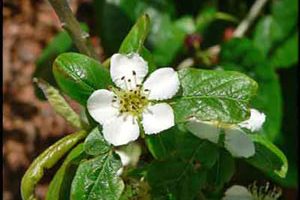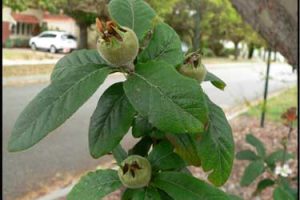Crataegus (Mespilus)germanica
Medlar
Origin
Native to the trans-Caucasian part of Asia Minor, then distributed to Greece in pre-Christian times and subsequently taken throughout southern Europe by the Romans. Taxonomists have only recently placed the medlar in the genus Crataegus on genetic evidence; it had previously been called Mespilus for many years. The medlar is diploid whereas many of the others in the genus are polyploids.
Climate
The medlar is a temperate climate fruit tree, but when mature they have been known to survive temperatures as low as -25°C.
Plant Description
A small, long-lived and very attractive deciduous tree. In cultivation it is usually thornless and can grow to 4-6m high whereas in the wild it is normally thorny and smaller. Bark is grey-brown on young branches becoming grey on older ones. The alternate spiral deep green coriaceous leaves are simple, elongate-oblong, 5-12cm long, with serrate or entire margins, pinnate venation, pubescent underneath, and turn an attractive orange-gold-red before abscission in autumn.
Relatives
It is a member of the large Rosaceae family of fruiting plants, some of which are: hawthorn, apple, pear, stone fruit, almond, loquat, quince, berry fruit and strawberry.
Soils
It can grow in a wide range of soils provided they are free-draining and have good moisture retention for lengthy hot summers.
Propagation
This is mainly by budding or grafting (whip) as seed germination and growth is very slow. Cuttings under mist are possible but not straight-forward. Suitable rootstocks depend largely on soil conditions, with quince used in moist soils and pear where it is drier or lime-induced chlorosis or cold winters are possible.
Cultivars
There are not many real cvs after discounting all the synonyms. The two most common are Nottingham and Dutch. The former is a prolific bearer of small, good quality, pyriform fruit, while the latter is a bigger tree with lower yield of bigger but less flavoursome fruit.
Flowering and Pollination
Terminal inflorescences on short shoots with one (less commonly two) white or light pink hermaphrodite flowers, 2-4cm wide, occurring in late spring or early summer. They have five sepals and five petals, an inferior ovary, 30-40 stamens and five carpels with each locule having two ovules. Moderate winter chilling is required to initiate flowering. Flowers are self-fertile with adequate fruit set in isolated trees. Bees and other insects are the principal pollinators although wind can also assist. Only one of the two ovules in each locule is fertilized, and some fruit set parthenocarpically.
Cultivation
They are best planted in a sunny position when dormant in autumn. If non-dormant container plants are transplanted in other seasons, they should be copiously watered for several weeks. Nutritional requirements are often minimal, but where necessary on infertile soils they should be fertilized similarly to apple trees. Mulch is beneficial, particularly in the early years.
Wind Tolerance
Relatively resistant.
Pruning
They should be trained into a vase shape when young by selecting 3-4 well-directed main scaffold branches. These should then be allowed to branch periodically at successively higher intervals to give a well-shaped canopy. The centre should be kept reasonably open to maximise light interception. Like apples, fruit are borne on spurs that are at least 2 years old, so care must be taken when pruning so as not to remove subsequent year’s crops inadvertently. Occasionally dead or overlapping branches may have to be removed.
The Fruit
The reddish-brown-skinned climacteric pome fruit, sub-globose or pyriform, 2-4cm in diameter and 10-70g depending on cv, has a persistent open-flared slightly pubescent calyx when fully ripe. There are normally five largish seeds. The flavour of ripe fruit has been likened to baked apple with a trace of cinnamon. Mineral content is higher than many fruit, and carbohydrate content when fully ripe is 12-25%.
Fruit Production and Harvesting
Fruit production for grafted plants may begin within two years, with full production possible in 6-7. There is some early self-thinning of fruitlets as with apples and pears. The remaining fruit are slow-growing, and while maturing in early autumn they are left on the tree till late autumn/early winter. Fruit picking is staggered, and if sufficiently mature they should detach easily from the spur but are still be very hard. As with astringent persimmons, they are then kept for a further 2-3 weeks until the fruit skin loses its green tint, becomes very soft and loses its astringency, a process termed ‘bletting’. In this ripening stage, pulp turns from a white to brownish shade, sugars increase (10-fold for glucose) and acids, antioxidants and tannins decrease. Like apples, cut fruit are subject to enzymatic browning more quickly than when remaining intact. Bletted fruit can be kept for 1-2 weeks, and yields of 30 kg/tree are achievable.
Fruit Uses
Traditionally they were an accompaniment to an after-meal glass of port. They can be eaten fresh by sucking or spooning out the pulp, leaving the thin skin and seeds. They can also be baked whole, roasted over a fire or used to make jams, jellies and syrups.
Pests and Diseases
Relatively free from diseases and insect attack. Occasional problems reported in Europe include: powdery mildew, brown rot, rust, leaf spot and leaf miner.
Comments
Medlar is an unusual plant not commonly grown outside of Europe, Asia Minor and Russia. Despite being a temperate zone species it flowers and sets fruit quite well in the south west of WA.

